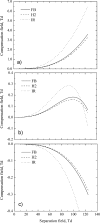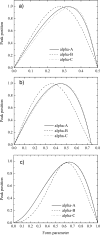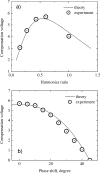Selection and generation of waveforms for differential mobility spectrometry
- PMID: 20192506
- PMCID: PMC2830256
- DOI: 10.1063/1.3284507
Selection and generation of waveforms for differential mobility spectrometry
Abstract
Devices based on differential mobility spectrometry (DMS) are used in a number of ways, including applications as ion prefilters for API-MS systems, as detectors or selectors in hybrid instruments (GC-DMS, DMS-IMS), and in standalone systems for chemical detection and identification. DMS ion separation is based on the relative difference between high field and low field ion mobility known as the alpha dependence, and requires the application of an intense asymmetric electric field known as the DMS separation field, typically in the megahertz frequency range. DMS performance depends on the waveform and on the magnitude of this separation field. In this paper, we analyze the relationship between separation waveform and DMS resolution and consider feasible separation field generators. We examine ideal and practical DMS separation field waveforms and discuss separation field generator circuit types and their implementations. To facilitate optimization of the generator designs, we present a set of relations that connect ion alpha dependence to DMS separation fields. Using these relationships we evaluate the DMS separation power of common generator types as a function of their waveform parameters. Optimal waveforms for the major types of DMS separation generators are determined for ions with various alpha dependences. These calculations are validated by comparison with experimental data.
Figures










Similar articles
-
Rapid separation and quantitative analysis of peptides using a new nanoelectrospray- differential mobility spectrometer-mass spectrometer system.Anal Chem. 2006 Aug 1;78(15):5443-52. doi: 10.1021/ac060003f. Anal Chem. 2006. PMID: 16878881
-
An atmospheric pressure ion funnel with a slit entrance for enhancing signal and resolution in high resolution differential ion mobility mass spectrometry.Analyst. 2022 Feb 28;147(5):870-879. doi: 10.1039/d1an01942b. Analyst. 2022. PMID: 35136893
-
Review of applications of high-field asymmetric waveform ion mobility spectrometry (FAIMS) and differential mobility spectrometry (DMS).Analyst. 2007 Sep;132(9):842-64. doi: 10.1039/b706039d. Epub 2007 Jun 26. Analyst. 2007. PMID: 17710259
-
Ion mobility-mass spectrometry.J Mass Spectrom. 2008 Jan;43(1):1-22. doi: 10.1002/jms.1383. J Mass Spectrom. 2008. PMID: 18200615 Review.
-
The hitchhiker's guide to dynamic ion-solvent clustering: applications in differential ion mobility spectrometry.Phys Chem Chem Phys. 2022 Sep 14;24(35):20594-20615. doi: 10.1039/d2cp02540j. Phys Chem Chem Phys. 2022. PMID: 36000315 Review.
Cited by
-
Increased Ion Transmission for Differential Ion Mobility Combined with Mass Spectrometry by Implementation of a Flared Inlet Capillary.J Am Soc Mass Spectrom. 2017 Jan;28(1):119-124. doi: 10.1007/s13361-016-1509-7. Epub 2016 Oct 17. J Am Soc Mass Spectrom. 2017. PMID: 27752912
-
DMS as an orthogonal separation to LC/ESI/MS/MS for quantifying isomeric cerebrosides in plasma and cerebrospinal fluid.J Lipid Res. 2019 Jan;60(1):200-211. doi: 10.1194/jlr.D089797. Epub 2018 Nov 9. J Lipid Res. 2019. PMID: 30413651 Free PMC article.
-
Maximizing Ion Transmission in Differential Mobility Spectrometry.J Am Soc Mass Spectrom. 2017 Oct;28(10):2151-2159. doi: 10.1007/s13361-017-1727-7. Epub 2017 Jun 29. J Am Soc Mass Spectrom. 2017. PMID: 28664477
-
Differential Mobility Spectrometry-Mass Spectrometry (DMS-MS) in Radiation Biodosimetry: Rapid and High-Throughput Quantitation of Multiple Radiation Biomarkers in Nonhuman Primate Urine.J Am Soc Mass Spectrom. 2018 Aug;29(8):1650-1664. doi: 10.1007/s13361-018-1977-z. Epub 2018 May 7. J Am Soc Mass Spectrom. 2018. PMID: 29736597 Free PMC article.
-
Development of rapid methodologies for the isolation and quantitation of drug metabolites by differential mobility spectrometry - mass spectrometry.Int J Ion Mobil Spectrom. 2012 Sep 1;15(3):10.1007/s12127-012-0111-3. doi: 10.1007/s12127-012-0111-3. Int J Ion Mobil Spectrom. 2012. PMID: 24311968 Free PMC article.
References
-
- Gorshkov M. P., SU 966,583 G01N27/62, 1982.
-
- Buryakov I. A., Krylov E. V., and Soldatov V. P., SU 1485808, G01N27/62, 1989.
-
- Buryakov I. A., Krylov E. V., Nazarov E. G., and Rasulev U. Kh., Int. J. Mass Spectrom. Ion Process. IJMPDN 128, 143 (1993).10.1016/0168-1176(93)87062-W - DOI
-
- Eiceman G. A. and Karpas Z., Ion Mobility Spectrometry, 2nd ed. (CRC, Boca Raton, 2004).
-
- Shvartsburg A. A., Differential Ion Mobility Spectrometry: Nonlinear Ion Transport and Fundamentals of FAIMS (CRC, Boca Raton, 2009).
Publication types
MeSH terms
Grants and funding
LinkOut - more resources
Full Text Sources
Other Literature Sources
Miscellaneous

